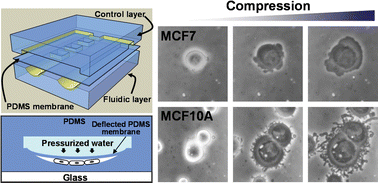Biomechanical analysis of cancerous and normal cells based on bulge generation in a microfluidic device
Abstract
This paper presents a new biomechanical analysis method for discrimination between cancerous and normal cells through compression by poly(dimethylsiloxane) (PDMS) membrane deflection in a microfluidic device. When a cell is compressed, cellular membrane will expand and then small bulges will appear on the peripheral cell membrane beyond the allowable strain. It is well known that the amount of F-actin in cancer cells is less than that of normal cells and bulges occur at the sites where cytoskeleton becomes detached from the membrane bilayer. Accordingly, we have demonstrated the difference of the bulge generation between breast cancer cells (MCF7) and normal cells (MCF10A). After excessive deformation, the bulges generated in MCF7 cells were not evenly distributed on the cell periphery. Contrary to this, the bulges of MCF10A cells showed an even distribution. In addition, the morphologies of bulges of MCF7 and MCF10A cells looked swollen protrusion and tubular protrusion, respectively. Peripheral strains at the moment of the bulge generation were also 72% in MCF7 and 46% in MCF10A. The results show that the bulge generation can be correlated with the cytoskeleton quantity inside the cell, providing the first step of a new biomechanical approach.


 Please wait while we load your content...
Please wait while we load your content...